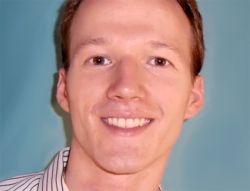
[2013-12-05] The Václav Votruba Prize is awarded annually by the Doppler Institute at the Technical University in Prague to the author of the best doctoral thesis in theoretical physics. This year Philipp Hauke, member of Peter Zollers research group, has been granted a Honourable Mention by the jury awarding the main prize.
The young physicist has been recognized for his doctoral thesis about quantum simulation with ultracold atoms. The jury decided to give a Honourable Mention to the “exceptionally well-written and impressive thesis.” The main prize has been awarded to Czech physicist Jaroslav Trnka, who earned a doctorate at Princeton and researches at Caltech.
Philipp Hauke carried out his PhD work in Maciej Lewenstein's research group at the Universitat Politècnica de Catalunya – Barcelona Tech and the Institute of Photonic Sciences in Castelldefels (Barcelona). With his thesis he expanded the theoretical foundation of quantum simulation. “On the one hand I discussed the general issue of reliability of the results of realistic error-prone quantum simulation,” says Hauke. “On the other hand, I explored possibilities to expand the catalogue of quantum problems that can be simulated by including non-standardized setups.” Many important questions of many-body quantum mechanics can be investigated by using quantum simulation. “Ultracold atoms in optical lattices and trapped ions are ideal candidates for quantum simulation as the precision to control them experimentally has increased dramatically in the last years,” explains the physicist.
In fact, quantum simulations in quantum optical systems that surpass the capacities of classical computers are already being carried out. In his distinguished work Philipp Hauke shows how the use of exotic lattice geometries, higher orbitals, or spin-dependent optical lattices may enable the simulation of a variety of interesting phenomena in solid body physics. These include magnetic quantum phase transitions, pair superfluidity, supersolidity and states that violate time-reversal invariance. “Moreover, through time-periodic driving of optical lattices we may be able to simulate frustrated antiferromagnets, synthetic gauge fields, topological insulators and anomalous quantum Hall effects,” describes Hauke the wide field of possibilities. Some of the examples have already been realized in experiments. “It is hoped that these developments will allow us to gather deep insights into some of the major problems of condensed-matter and high-energy physics in the near future,” says the junior scientists confidently.
About Philipp Hauke
Philipp Hauke studied physics at the TU Munich and EPF Lausanne and wrote his master thesis under the supervision of Ignacio Cirac in Garching near Munich. In 2012 he completed his PhD with distinction at the Institute of Photonic Sciences in Barcelona. Since fall 2012 he has worked with Prof. Peter Zoller at the Institut for Quantum Optics and Quantum Information of the Austrian Academy of Sciences.